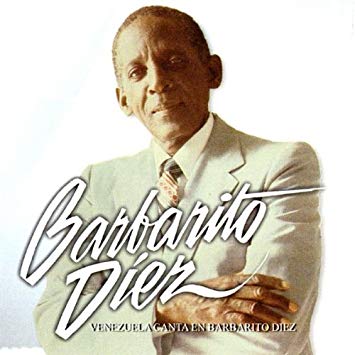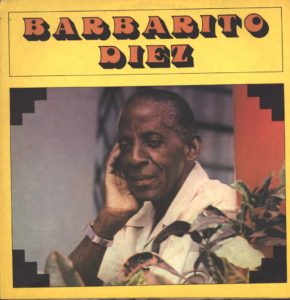 BARBARITO DIEZ, CANTANTE Y LEYENDA CUBANA CONOCIDO COMO “LA VOZ DEL DANZÓN”.
BARBARITO DIEZ, CANTANTE Y LEYENDA CUBANA CONOCIDO COMO “LA VOZ DEL DANZÓN”.
Una venerada y certificada leyenda de la música cubana, Bárbaro Diez Junco representa al mejor vocalista romántico masculino en la historia del danzón. Como estilista relajado pero romántico, tenía una voz tenor amigable con una dicción correcta y un sentido fácil de sentir, lo que evitó que la música tradicional cubana fuera invadida por pálidas imitaciones de cantantes de ópera masculinos a principios del siglo XX.
Barbaro Diez Junco nació en Bolondrón, Provincia de Matanzas el 4 de diciembre de 1909, Barbarito fue el rey de la música romántica en Cuba, y con sus canciones y danzones se enamoraron tres o cuatro generaciones de cubanos. Nunca será suficientemente homenajeado y recordado por quienes gusten de la música de la Isla, y vivan dentro o fuera de Cuba. Nadie en el mundo, ningún cantante de ningún país, se parece a Barbarito ni posee su melodía, su afinación perfecta, su musicalidad absoluta en canciones tan hermosas como Las perlas de tu boca, de Eliseo Grenet, o Si llego a besarte, de Luis Casas Romero.
A finales de los años veinte ya se le podía escuchar cantando en decenas de fiestas públicas y bailables. Barbarito fue de los pocos intérpretes que llevó su arte por toda la Isla y cantó en los más recónditos lugares, desde sus inicios en el canto, allá en el batey del central azucarero Manatí, el pueblo donde creció.
La larguísima carrera de Barbarito Diez toma un giro más profesional cuando formó el trío Los Gracianos, luego llamado Grupo Selecto, con el trovador Graciano Gómez y el trecero Isaac Oviedo. Canciones de Graciano Gómez como ‘Yo sé de una mujer’ y ‘En falso’, serían colocadas por el cantante entre lo mejor de la música cubana de esa época.
https://youtu.be/pWWthL2tKUQ
El Grupo Selecto, rebautizado como Quinteto Matancero, era punto fijo en el Café Vista Alegre, base de operaciones de los trovadores habaneros a lo largo de los años treinta y cuarenta. En ese lugar, Barbarito aprendió muchísimo de Sindo Garay y del maestro de la armonía Vincente González Rubiera, conocido artísticamente como Guyún. Allí lo conoció el famoso pianista danzonero Antonio María Romeu.
A partir de 1935 ingresó como voz solista en la orquesta del director y arreglista Antonio María Romeu. Con esta orquesta Barbarito interpretó danzones, sones y boleros, por más de cinco décadas, incluso después de la muerte del director, en 1955. Grandes éxitos fueron Boda gris, de Plácido Acevedo; Te odio, de Félix B. Caignet.
En la segunda mitad de los años treinta, Barbarito Diez, como voz solista del a orquesta de Antonio María Romeu, devino ícono obligado en La Habana romántica de esa década. Juntos recrearon temas que pertenecen a la antología de la música cubana: ‘Muñeca de cristal’ y ‘Se fue’, de Ernesto Lecuona; ‘Yo reiré cuando tú llores’, de Alberto Villalón; ‘La guinda’, de Eusebio Delfín; o ‘La Mora’, de Eliseo Grenet.
En los años cincuenta tiene lugar una verdadera explosión discográfica en la carrera del cantante, pues siete álbumes con la orquesta de Romeu, y dos discos sencillos junto al Conjunto Continental. Desde la segunda mitad de los años cincuenta, la antigua orquesta de Antonio María Romeu toma el nombre de Barbarito Diez y su orquesta y otros éxitos se incorporaron a su extenso repertorio: El amor de mi bohío, de Julio Brito; Tú no comprendes y Lamento borincano, de Rafael Hernández; Mujer, de Agustín Lara, y Esas no son cubanas, de Ignacio Piñeiro.
Barbarito fue de los cantantes de enorme prestigio antes de la Revolución que se quedaron en Cuba. En 1976, el ICAIC le dedica el documental Barbarito Diez, de Santiago Villafuerte, que reconocía sus medulares aportes a la música cubana. A lo largo de los años sesenta y setenta abundaban sus presentaciones en musicales de la televisión, Barbarito devino el más sólido baluarte de cubanía en términos musicales.
En 1984, con cincuenta años de exitosa carrera en sus espaldas, su popularidad reverdeció, en Cuba y otros países de América Latina, cuando grabó en Venezuela un LP de canciones con guitarras acompañado por la Rondalla Venezolana. Esta producción incluyó clásicos como Frenesí, Caballo viejo, Idolatría y Arroyito de mi Pueblo.
En 2007 la EGREm lo incluye en su prestigiosa serie Las voces del siglo, y al año siguiente, en las notas al disco Antonio María Romeu, El mago de las teclas, editado por la SGAE, el periodista Jordi Pujol asegura que Barbarito Diez poseía una voz «insólitamente hermosa».
La XV edición del Festival de Música Popular Barbarito Diez está ocurriendo ahora mismo en Las Tunas y Manatí hasta el 4 de diciembre, cuando se cumplirán 110 años del natalicio. En el Festival se incluye un bailable en la Plaza Cultural de Las Tunas, y también un panel conducido por Pablo Diez, quien dirige la orquesta cuyo nombre honra a su padre.
 BARBARITO DIEZ, SINGER AND CUBAN LEGEND KNOWN AS “THE VOICE OF THE DANZON”.
BARBARITO DIEZ, SINGER AND CUBAN LEGEND KNOWN AS “THE VOICE OF THE DANZON”.
A revered and certified legend of Cuban music, Bárbaro Diez Junco represents the best male romantic vocalist in the history of danzón. As a relaxed but romantic stylist, he had a friendly tenor voice with correct diction and an easy sense to feel, which prevented traditional Cuban music from being invaded by pale imitations of male opera singers in the early 20th century.
Barbaro Diez Junco was born in Bolondrón, Matanzas Province on December 4, 1909, Barbarito was the king of romantic music in Cuba, and three or four generations of Cubans fell in love with his songs and danzones. It will never be sufficiently honored and remembered by those who like the music of the Island and live inside or outside Cuba. No one in the world, no singer from any country, resembles Barbarito or possesses his melody, his perfect tuning, his absolute musicality in such beautiful songs as The pearls of your mouth, by Eliseo Grenet, or If I get to kiss you, by Luis Romero houses.
At the end of the twenties, he could already be heard singing in dozens of public and danceable parties. Barbarito was one of the few performers who took his art all over the Island and sang in the most remote places, from his beginnings in singing, there in the batey of the Manatí sugar mill, the town where he grew up.
The very long career of Barbarito Diez takes a more professional turn when he formed the Los Gracianos trio, then called Grupo Selecto, with the troubadour Graciano Gómez and the thirteen Isaac Oviedo. Songs of Graciano Gómez as ‘I know of a woman’ and ‘In false’, would be placed by the singer among the best of Cuban music of that time.
The Select Group, renamed Quinteto Matancero, was a fixed point at Café Vista Alegre, the base of Havana troubadour operations throughout the thirties and forties. In that place, Barbarito learned a lot from Sindo Garay and the harmony master Vincente González Rubiera, artistically known as Guyún. There he met the famous Danish pianist Antonio María Romeu.
From 1935 he entered as soloist voice in the orchestra of the conductor and arranger Antonio María Romeu. With this orchestra, Barbarito performed dances, sounds, and boleros, for more than five decades, even after the director’s death, in 1955. Big hits were Gray Wedding, by Plácido Acevedo; I hate you, by Felix B. Caignet;
In the second half of the thirties, Barbarito Diez, as a soloist of the orchestra of Antonio María Romeu, became an obligatory icon in the romantic Havana of that decade. Together they recreated themes that belong to the anthology of Cuban music: ‘Muñeca de cristal’ and ‘Se se’ by Ernesto Lecuona; ‘I will laugh when you cry’, by Alberto Villalón; ‘La icing’, by Eusebio Delfín; or ‘La Mora’, by Eliseo Grenet.
In the fifties, a real record explosion takes place in the singer’s career, as seven albums with the orchestra of Romeu, and two simple albums with the Continental Ensemble. From the second half of the fifties, the old orchestra of Antonio María Romeu takes the name of Barbarito Diez and his orchestra and other successes were incorporated into his extensive repertoire: The love of my bohío, by Julio Brito; You do not understand and Lamento borincano, by Rafael Hernández; Woman, by Agustín Lara, and Those are not Cuban, by Ignacio Piñeiro.
Barbarito was one of the singers of great prestige before the Revolution who stayed in Cuba. In 1976, ICAIC dedicated the documentary Barbarito Diez, by Santiago Villafuerte, that recognized his core contributions to Cuban music. Throughout the sixties and seventies his presentations in television musicals abounded, Barbarito became the most solid bastion of Cuban in musical terms.
In 1984, with fifty years of a successful career on his back, his popularity grew green in Cuba and other Latin American countries, when he recorded in Venezuela an LP of songs with guitars accompanied by the Venezuelan Rondalla. This production included classics such as Frenzy, Old Horse, Idolatry and Arroyito de mi Pueblo.
In 2007 the EGREm includes it in its prestigious series The Voices of the Century, and the following year, in the notes to the album Antonio María Romeu, The Wizard of the Keys, edited by the SGAE, the journalist Jordi Pujol assures that Barbarito Diez had an “Unusually beautiful” voice.
The XV edition of the Barbarito Diez Popular Music Festival is happening right now in Las Tunas and Manatí until December 4, when 110 years of birth will be celebrated. The Festival includes the dance in the Plaza Cultural de Las Tunas, and also a panel conducted by Pablo Diez, who conducts the orchestra whose name honors his father.
Agencies/ Wiki/ CiberCuba/ Joel del Río/ Extractos/ Excerpts/ Internet Photos/ YouTube/ Arnoldo Varona/ www.TheCubanHistory.com
THE CUBAN HISTORY, HOLLYWOOD.








